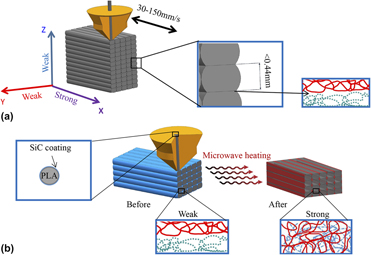Crossref Citations
This article has been cited by the following publications. This list is generated based on data provided by
Crossref.
Kakanuru, Padmalatha
and
Pochiraju, Kishore
2020.
Moisture Ingress and Degradation of Additively Manufactured PLA, ABS and PLA/SiC Composite Parts.
Additive Manufacturing,
Vol. 36,
Issue. ,
p.
101529.
Lee, Ching Hao
Padzil, Farah Nadia Binti Mohammad
Lee, Seng Hua
Ainun, Zuriyati Mohamed Asa’ari
and
Abdullah, Luqman Chuah
2021.
Potential for Natural Fiber Reinforcement in PLA Polymer Filaments for Fused Deposition Modeling (FDM) Additive Manufacturing: A Review.
Polymers,
Vol. 13,
Issue. 9,
p.
1407.
Shaik, Yousuf Pasha
Schuster, Jens
Shaik, Aarif
Mohammed, Mustafa
and
Katherapalli, Harshavardhan Reddy
2021.
Effect of Autoclave Pressure and Temperature on Consolidation of Layers and Mechanical Properties of Additively Manufactured (FDM) Products with PLA.
Journal of Manufacturing and Materials Processing,
Vol. 5,
Issue. 4,
p.
114.
Mohammadizadeh, Mahdi
and
Fidan, Ismail
2021.
Tensile Performance of 3D-Printed Continuous Fiber-Reinforced Nylon Composites.
Journal of Manufacturing and Materials Processing,
Vol. 5,
Issue. 3,
p.
68.
Tamburrino, F.
Barone, S.
Paoli, A.
and
Razionale, A. V.
2021.
Post-processing treatments to enhance additively manufactured polymeric parts: a review.
Virtual and Physical Prototyping,
Vol. 16,
Issue. 2,
p.
221.
Ehrmann, Guido
Brockhagen, Bennet
and
Ehrmann, Andrea
2021.
Shape-Memory Properties of 3D Printed Cubes from Diverse PLA Materials with Different Post-Treatments.
Technologies,
Vol. 9,
Issue. 4,
p.
71.
Tian, Xiaoyong
Todoroki, Akira
Liu, Tengfei
Wu, Lingling
Hou, Zhanghao
Ueda, Masahiro
Hirano, Yoshiyasu
Matsuzaki, Ryosuke
Mizukami, Koichi
Iizuka, Keisuke
Malakhov, Andrei V.
Polilov, Alexander N.
Li, Dichen
and
Lu, Bingheng
2022.
3D Printing of Continuous Fiber Reinforced Polymer Composites: Development, Application, and Prospective.
Chinese Journal of Mechanical Engineering: Additive Manufacturing Frontiers,
Vol. 1,
Issue. 1,
p.
100016.
Cao, Mengyu
Cui, Tianqi
Yue, Yuhang
Li, Chaoyu
Guo, Xue
Jia, Xin
and
Wang, Baojin
2022.
Investigation of Carbon Fiber on the Tensile Property of FDM-Produced PLA Specimen.
Polymers,
Vol. 14,
Issue. 23,
p.
5230.
Sun, Yufeng
Wang, Yapeng
Mu, Wenlong
Zheng, Zipeng
Yang, Bin
Wang, Jinwei
Zhang, Runkai
Zhou, Kaiyuan
Chen, Liang
Ying, Jilai
Liu, Xinping
and
Xu, Guangyin
2022.
Mechanical properties of 3D printed micro‐nano rice husk/polylactic acid filaments.
Journal of Applied Polymer Science,
Vol. 139,
Issue. 28,
Tran, Thang Q.
Ng, Feng Lin
Kai, Justin Tan Yu
Feih, Stefanie
and
Nai, Mui Ling Sharon
2022.
Tensile Strength Enhancement of Fused Filament Fabrication Printed Parts: A Review of Process Improvement Approaches and Respective Impact.
Additive Manufacturing,
Vol. 54,
Issue. ,
p.
102724.
Wang, Yanqing
Wang, Xin
Xie, Minghui
Zhou, Zheng
and
Xu, Huan
2022.
A surface modification of polylactic acid composites for additive manufacturing with modified chopped carbon fiber and modified nano‐hydroxyapatite.
Polymer Composites,
Vol. 43,
Issue. 11,
p.
7859.
Shaik, Yousuf Pasha
Schuster, Jens
Katherapalli, Harshavardhan Reddy
and
Shaik, Aarif
2022.
3D Printing under High Ambient Pressures and Improvement of Mechanical Properties of Printed Parts.
Journal of Composites Science,
Vol. 6,
Issue. 1,
p.
16.
Andreu, Alberto
Kim, Sanglae
Dittus, Jörg
Friedmann, Marco
Fleischer, Jürgen
and
Yoon, Yong-Jin
2022.
Hybrid material extrusion 3D printing to strengthen interlayer adhesion through hot rolling.
Additive Manufacturing,
Vol. 55,
Issue. ,
p.
102773.
Zhou, Mengnan
Chen, Bichi
Li, Yaozong
Jiang, Junjie
and
Zhai, Wentao
2023.
Enhanced Interfacial Adhesion and Increased Isotropy of 3D Printed Parts with Microcellular Structure Fabricated via a Micro‐Extrusion CO2‐Foaming Process.
Advanced Engineering Materials,
Vol. 25,
Issue. 8,
Hauschel, Adam B.
Carey, Daniel G.
Fishbeck, Blake J.
Coleman, Bryan J.
Carroll, Jacob M.
Mustafa, Mazin M.
Sarmah, Anubhav
Price, Carey D.
and
Green, Micah J.
2023.
Automated deposition and Joule heating of carbon ink for the generation of on-demand unique thermal patterns.
Journal of Materials Research,
Vol. 38,
Issue. 8,
p.
2137.
Figueiredo, Sara
Fernandes, Ana I.
Carvalho, Fátima G.
and
Pinto, João F.
2023.
Exploring Environmental Settings to Improve the Printability of Paroxetine-Loaded Filaments by Fused Deposition Modelling.
Pharmaceutics,
Vol. 15,
Issue. 11,
p.
2636.
Wang, Zhaogui
Yin, Xiuzeng
and
Wang, Lihan
2023.
Tensile properties of sandwich-designed carbon fiber filled PLA prepared via multi-material additive layered manufacturing and post-annealing treatment.
International Polymer Processing,
Vol. 38,
Issue. 3,
p.
343.
Ganapathy, Sakthi Balan
Sakthivel, Aravind Raj
Kandasamy, Jayakrishna
Khan, Tabrej
and
Aloufi, Mansour
2023.
Optimization of Printing Process Variables and the Effect of Post-Heat Treatments on the Mechanical Properties of Extruded Polylactic Acid–Aluminum Composites.
Polymers,
Vol. 15,
Issue. 24,
p.
4698.
Antonio, Erik L. S.
Anik, Arefin M.
Kuksenok, Olga
and
Luzinov, Igor
2023.
Enhancement of Polypropylene 3D-Printed Structures via the Addition of SiC Whiskers and Microwave Irradiation.
ACS Applied Materials & Interfaces,
Vol. 15,
Issue. 33,
p.
40042.
Neijhoft, Jonas
Henrich, Dirk
Kammerer, Andreas
Janko, Maren
Frank, Johannes
and
Marzi, Ingo
2023.
Sterilization of PLA after Fused Filament Fabrication 3D Printing: Evaluation on Inherent Sterility and the Impossibility of Autoclavation.
Polymers,
Vol. 15,
Issue. 2,
p.
369.
